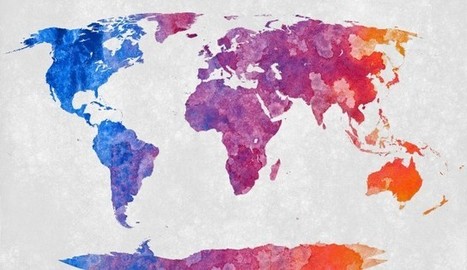The evolution of human culture is often compared to biological evolution, and it’s easy to see why: both involve variation across a population, transmission of units from one generation to the next, and factors that ensure the survival of some variants and the death of others. However, sometimes this comparison fails. Culture, for instance, can be transmitted “horizontally” between members of the same generation, but genes can’t.
“Little is known about whether human demographic history generates patterns in linguistic data that are similar to those found in genetic data,” write the authors of a recent paper in PNAS. Both linguistic and genetic data can be used to draw conclusions about human history, but it's vital to understand how the forces affecting them differ in order to be sure that the conclusions we're drawing are accurate.
By conducting a large-scale analysis on global genetic and linguistic data, the researchers found that languages sometimes behave in ways very unlike genetics. For instance, isolated languages have more, not less, diversity, and languages don't retain the echo of a migration out of Africa—unlike our genomes.
To conduct the analysis, the researchers focused on “phonemes,” which are the smallest linguistic units of sound that can distinguish meaning. For instance, English uses “p” and “b” to distinguish between the words “pat” and “bat,” which means “p” and “b” act as phonemes. Other languages may not use these particular sounds to distinguish words—or they may make finer distinctions, basing meaning differences on subtle changes like whether or not a puff of air follows the “p.”
Every language has a certain number of phonemes, and these phoneme inventories differ in size from language to language. The researchers compared information on global phoneme inventories with data on global genetics and geographic location in order to isolate how phonemic and genetic units track each other.
Some of their results were intuitive. They found that populations with greater geographical distance between them also had larger genetic and phonemic differences. Languages that come from the same family (like French and Italian) could be expected to have similar phoneme inventories, but the finding held true even for geographically close but historically unrelated languages.
However, some of their results were not quite as intuitive. When populations migrate, genetic diversity goes down, because the group that moves takes along only a portion of the gene pool of their original population. Isolated groups of people, who have no opportunity to mingle with other groups, therefore have limited genetic diversity. Language, on the other hand, shows the opposite pattern: languages with lots of close neighbors seem to be influenced by these neighbors, leading to less phonemic diversity over time. Isolated languages, on the other hand, change over the generations to become more diverse.
The most surprising finding was that, unlike genetic data, the human migration out of Africa has not left traces on modern linguistic data. This contradicts previous work in the field suggesting that, as with genetics, language diversity declines with distance from Africa, as a result of populations breaking off and moving farther away. The authors of the new paper suggest that language changes faster than genetics, and it's less determined by the size and characteristics of a migrating population, leading to markedly different patterns in phonemic and genetic data.
“This is a very interesting and important addition to the field, not only because it uses such a large database and introduces (relatively) new methods to the field, but also because of its findings,” says Dr. Dan Dediu, who researches linguistics and genetics at the Max Planck Institute for Psycholinguistics in Nijmegen, The Netherlands. “If its main finding survives replication with other databases and methods, then it’s a very powerful confirmation of the idea that demographic processes are one of the main driving forces behind both linguistic and genetic diversity."
“It also highlights the fact that language and genes have different properties, especially when it comes to small, isolated communities and contact between populations,” he adds.
However, Dediu suggests that different assumptions about how sound change works could result in different results. He explains that not all phoneme changes happen with equal ease; for instance, due to their similarity, the sounds “b” and “p” can change into each other much more easily than the sounds “ee” and “k.” If two languages have sounds more similar to each other than to a third language, they are linguistically closer to each other, even if all three languages have the same size phoneme inventories. “I don’t know what the results would look like with a more realistic model of change, but they might look slightly different,” he says.
Via Charles Tiayon



 Your new post is loading...
Your new post is loading...








One thing that I found really interesting about this articles was when the author stated that as people move, "genetic diversity goes down, because the group that moves takes along only a portion of the gene pool of their original population" and isolated people have "limited genetic diversity." Languages operate almost oppositely as isolated languages "change over generations" and "become more diverse."